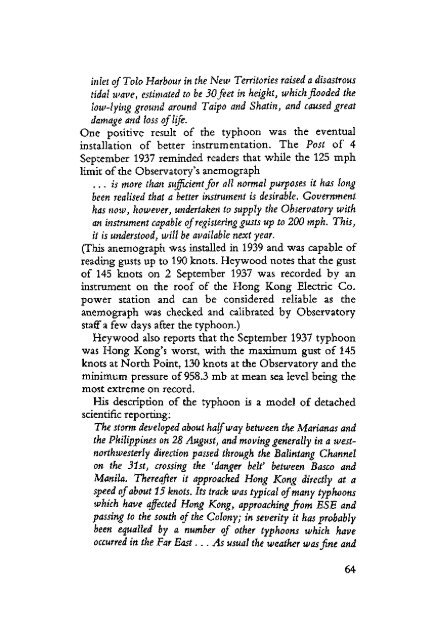Royal - HKU Libraries - The University of Hong Kong
Royal - HKU Libraries - The University of Hong Kong
Royal - HKU Libraries - The University of Hong Kong
Create successful ePaper yourself
Turn your PDF publications into a flip-book with our unique Google optimized e-Paper software.
inlet <strong>of</strong> Tola Harbour in the New Territories raised a disastroustidal wave, estimated to be 30 feet in height, which flooded thelow-lying ground around Taipo and Shatin, and caused greatdamage and loss <strong>of</strong> life.One positive result <strong>of</strong> the typhoon was the eventualinstallation <strong>of</strong> better instrumentation. <strong>The</strong> Post <strong>of</strong> 4September 1937 reminded readers that while the 125 mphlimit <strong>of</strong> the Observatory's anemograph... is more than sufficient for all normal purposes it has longbeen realised that a better instrument is desirable. Governmenthas now, however, undertaken to supply the Observatory withan instrument capable <strong>of</strong> registering gusts up to 200 mph. This,it is understood, will be available next year.(This anemograph was installed in 1939 and was capable <strong>of</strong>reading gusts up to 190 knots. Hey wood notes that the gust<strong>of</strong> 145 knots on 2 September 1937 was recorded by aninstrument on the ro<strong>of</strong> <strong>of</strong> the <strong>Hong</strong> <strong>Kong</strong> Electric Co.power station and can be considered reliable as theanemograph was checked and calibrated by Observatorystaff a few days after the typhoon.)Hey wood also reports that the September 1937 typhoonwas <strong>Hong</strong> <strong>Kong</strong>'s worst, with the maximum gust <strong>of</strong> 145knots at North Point, 130 knots at the Observatory and theminimum pressure <strong>of</strong> 958.3 mb at mean sea level being themost extreme on record.His description <strong>of</strong> the typhoon is a model <strong>of</strong> detachedscientific reporting:<strong>The</strong> storm developed about halfway between the Marianas andthe Philippines on 28 August, and moving generally in a westnorthwesterlydirection passed through the Balintang Channelon the 31st, crossing the 'danger belf between Basco andManila. <strong>The</strong>reafter it approached <strong>Hong</strong> <strong>Kong</strong> directly at aspeed <strong>of</strong> about 15 knots. Its track was typical <strong>of</strong> many typhoonswhich have affected <strong>Hong</strong> <strong>Kong</strong>, approaching from ESE andpassing to the south <strong>of</strong> the Colony; in severity it has probablybeen equalled by a number <strong>of</strong> other typhoons which haveoccurred in the Far East. .. As usual the weather was fine and64
















